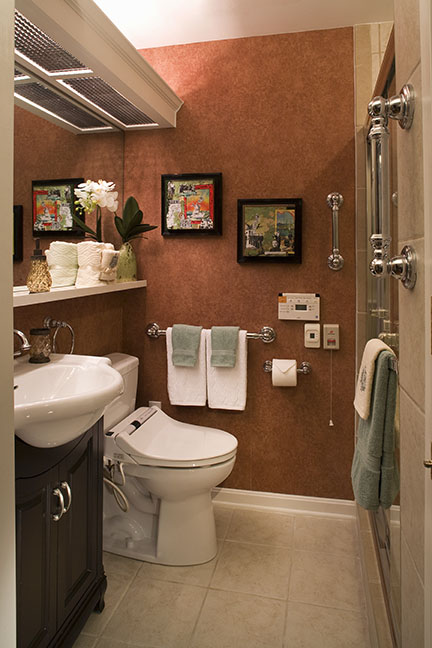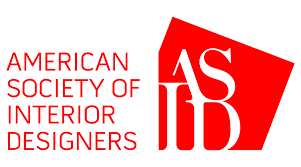Designing to Accommodate the Aging Eye
Moira Quinn Leite
President, M. Quinn Designs, Inc.
Michael Leite, PE
President, Luminous Environments, Inc
Introduction
This article examines design considerations to accommodate the aging eye in the home and workplace. In addition to the structural problems of nearsightedness, farsightedness and astigmatism, the eye and our visual system continue to change as we go from childhood through adulthood. We are concerned with creating inviting, comfortable environments and nothing discussed should deter readers from seeking regular assessments of their eyesight from qualified professionals.
Structural Changes
The structural process in the aging eye is called presbyopia. One manifestation is an increase in farsightedness over time; this is usually not a problem for the nearsighted individual. The second manifestation is a reduction in the depth of field or the range of distances at which the eye can clearly focus objects. It is caused by a hardening of the lens and a weakness in the muscle that rings it and causes the lens to change its focus. The typical solution is to hold objects at a distance or to change to multiple sets of glasses, bifocals and trifocals. From a design standpoint, an increase in the illumination level from a properly placed light source can partially mitigate the problem. The increase in light level causes the pupil to constrict and the eye behaves like a “pin-hole” camera.

Color Perception
The perception of color is a second element of change as the eye ages. Typically, the eye loses sensitivity in the blue portion of the spectrum over time. This is caused by a yellowing of the membrane that sheathes the retina on the back of the eye. If we think of the optical structure of the eye as very complex organic plastics, we may then visualize the yellowing as the same process as is seen in the plastic lenses of light fixtures that are exposed to ultraviolet light.
Design Options
For the designer, the loss in blue sensitivity poses several problems. It is possible to increase the blue spectral component through the selection of light sources; or, the color palette may be chosen to provide increased reflectance in the blue hues. The difficulty arises when the space must also accommodate the “normal” young eye and not present a distorted view of the space. The solution is the careful selection of the color palette for the space with careful attention to metamerism, a color shift due to a change in light source. The second element is the use of high color-rendering light sources like quartz-halogen lamps and tri-phosphor fluorescent and LED lamps which come in a variety of color temperatures from warm to very cool. Each of these sources offer greater energy efficiency and lamp life over standard incandescent lamps.
The Visual Environment
In the space itself, edges and transitions must be clearly delineated. This may be accomplished though the selection of contrasting colors, textures and reflectances. The placement of the light sources is also important; glare and veiling luminances must be avoided. An improperly placed light source can increase the illumination and energy required to perform a task. Properly placed, the light sources lead the occupants through a space and provide the visual cues for safe passage and task accomplishment.
The proper placement of visual stimuli and their illumination are essential to the creation of the visual environment. These include artwork, display items and accessories that are placed throughout the space in conjunction with accent lighting. While much of the resident’s time may be spent reading, sewing of performing close-in tasks, visual health requires the eye to relax every few minutes; this is accomplished by providing many objects in the visual field upon which to focus.
Visual Task Considerations
Because a multitude of visual tasks are performed in the space, multiple light sources and controls must be provided to allow flexibility for the resident to vary the visual environment. These may include switches, dimmers, remote controls and occupancy sensors. Occupancy sensors can turn on the illumination before the occupant reaches a hazardous location and saves energy by extinguishing the lighting when no one is present. Diffuse and indirect light sources are useful for general illumination; however, direct or point sources may be desirable when structure, contrast or shadowing are important.
Daylighting
Daylight is another consideration in the design of spaces. There are two key considerations. First, the color palette of the space must be compatible with the introduction of daylight in addition to it coordination with the electric lighting. The use of tinted glass can also complicate the design trade-offs. Second, illumination requirements are greater during daylight hours because the eye has adapted to the higher ambient light levels. This dictates that more illumination is required in the rear or darker portions of the space during the day and that general illumination levels may be reduced as nighttime approaches. Care must be taken in the selection of window treatments to ensure that they control the daylight so that tasks can be comfortably performed.
Conclusions
As the eye ages, changes take place that reduce visual performance. By paying careful attention to the selection of light sources and the design of the visual environment, occupants can perform their daily routine comfortably and productively.
About the Authors
With over thirty years of experience in Lighting and Interior Design, Moira Quinn Leite is the President and Design Principal of M. Quinn Designs Incorporated. The firm has offices in Edina, Minnesota, and Annandale, Virginia. She is a member of the Illuminating Engineering Society of North America, the International Furnishings and Design Association, and Allied Member of the American Society of Interior Designers.
Michael Leite is a Registered Professional Engineer with Luminous Environments, Incorporated. His experience includes indoor and outdoor lighting, low-level photometry, and marine lighting. His papers have been published by the CIE, IESNA, American Society of Naval Engineers, and the American Society of Civil Engineers. He holds a patent for optical waveguide technology and was the editor for the Recommended Practice for Marine Lighting published by the IESNA.
©2021, M. Quinn Designs, Inc.
Luminous Environments
Meeting Your Needs | Benefits from Our Services | Our Services
Meeting Your Needs
Luminous Environments provides specialty lighting services to the residential, display, retail, and commercial markets–for situations in which the visual task is the major concern.
Lighting affects sales; it draws in customers; it determines the mood. From a technical standpoint, lighting quantity determines the ability to accomplish a task properly. From an esthetic perspective, lighting quality reflects our comfort in a space.
Quality lighting does not have to be costly. Rather it generates a solid return on your investment. A good lighting system is efficient. The proper sources are selected to meet your specific needs.
Lighting in most spaces should not be a focal point. Attention should be directed to the merchandise, the art being illuminated, or the members of a dinner party.
Lighting can be exciting. It can bring works or art to life. It can develop surface features. It can become an art object in itself.
Even businesses with installed systems and limited capital can obtain better lighting through optimization of their existing equipment.
In the residence, lighting sets the mood, compensates for visual limitations, ensures visibility and promotes safety. The color or spectral composition of the light affects mood and biorhythms; it also affects visibility for people with visual limitations.
Many of the newer sources offer good color rendering, long life, and energy efficiency. Similarly, light control is critical to lighting quality. To prevent glare and achieve the correct light distribution, the proper selection must be made from the many lamp types and light sources.
Benefits from Our Services
- Quality illumination brings your environment to life.
- Reduced energy use for lighting –as much as 40 to 60 percent less.
- Proper lamp selection means longer life, fewer burnouts and lower maintenance costs.
- The color of light is matched to your space, display goals, and needs.
- Quick response for design and lighting consultation.
Our Services
Design+ Lighting System Service allows you to reconfigure your present system to meet the changing needs of your company. Emphasis is placed on retrofit, relamping, and other fine tuning of your existing equipment. For store owners and galleries, Design+ service can provide the services of a lighting designer on a regular schedule to fine tune the lighting to meet the requirements of seasonal displays and exhibits.
Key Products Service supplies specialty lighting products in the small quantities required for replacement and retrofit. We concentrate on quality equipment and replacement components. Our goal is to keep your system operating at its optimum level.
Affiliated Services of Luminous Environments allow us to bring in specialists to solve your design and application problems. Through our affiliates we can provide design, space planning and installation supervision services. Additionally we can source the products and accessories required for your project. We can provide you with the names of licensed and bonded general and electrical contractors to perform construction and installation services.
Contact Information
Telephone: (703) 354-6359






